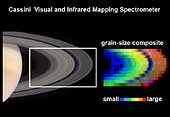|
COMETS EARTH JUPITER KUIPER BELT MARS MERCURY METEORITES NEPTUNE OORT CLOUD PLUTO SATURN SOLAR SYSTEM SPACE SUN URANUS VENUS ORDER PRINTS
PHOTO CATEGORIES SCIENCEVIEWS AMERICAN INDIAN AMPHIBIANS BIRDS BUGS FINE ART FOSSILS THE ISLANDS HISTORICAL PHOTOS MAMMALS OTHER PARKS PLANTS RELIGIOUS REPTILES SCIENCEVIEWS PRINTS
|
Related Documents
Download Options
Evidence from the visual and infrared mapping spectrometer on the Cassini spacecraft indicates that the grain sizes in Saturn's rings grade from smaller to larger, related to distance from Saturn. Those data (right) are shown next to a corresponding picture of the rings taken by Cassini's narrow angle camera. Saturn's rings are thought to be made up of boulder-size snowballs. By looking at the rings with the visual and infrared mapping spectrometer, the size of the ice crystals, or grains, on the surfaces of those boulders can be determined. This visual and infrared mapping spectrometer has a spatial resolution similar to that of the human eye, so it provides a view analogous to standing on the spacecraft. Only instead of looking at the rings in visible wavelengths, the instrument sees wavelengths beyond what human eyes can see, ranging from the ultraviolet to the infrared. The latest observations show that grain sizes range from very small, like powdery snow on Earth, to larger grains, like more granular snow. The visual and infrared mapping spectrometer can also see the fingerprint signatures of chemical bonds, and, in this case, it spotted the bonds of frozen water molecules. Saturn's rings are made mostly of water in the form of ice. While this has been known for many years, the Cassini data are showing that the ring ice is more pure than previously thought, with the most pure ices generally being observed at increasing distances from Saturn. |
